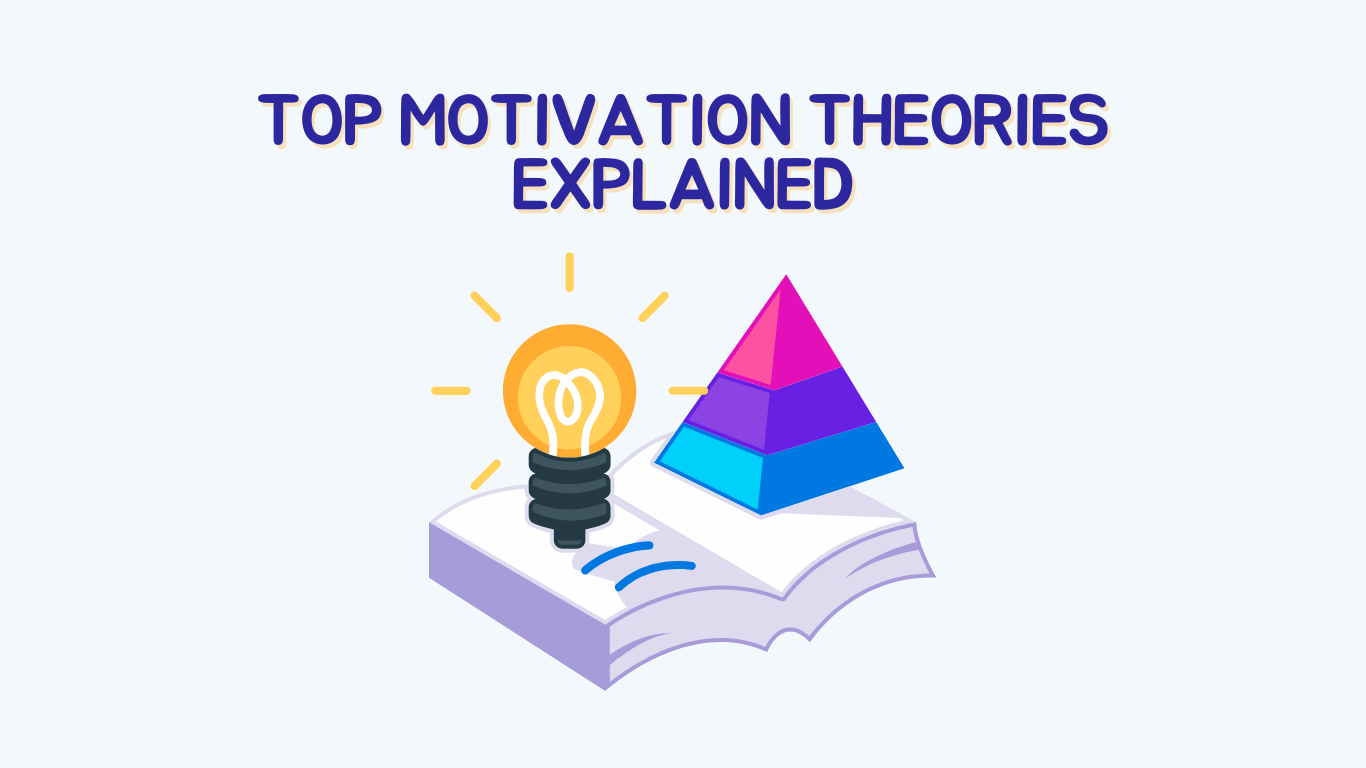Have you ever wondered what actually drives us to achieve our goals? This article takes a deep dive into motivation and motivation theories, explaining key psychological frameworks and their applications in everyday life.

Key Takeaways
- Motivation is a complex interplay of internal and external factors that drives goal-directed behavior. It is heavily influenced by emotions and incentives.
- Content theories focus on specific needs that shape motivation, while process theories examine the mechanisms through which motivation evolves over time. Cognitive theories emphasize the role of thought processes in driving motivation.
- Applying motivation theories in real-world settings—like workplaces and educational environments—can enhance motivation and improve outcomes through tailored strategies.

Understanding Motivation
Motivation is the invisible force that propels us to act, guiding our behaviors and decisions. It’s a mixture of internal and external factors that steer us toward our goals. At its core, motivation is about initiating and sustaining activities that are goal-oriented. Whether it’s acing a test, landing that dream job, or simply getting out of bed in the morning, motivation is what gets us moving and keeps us going.
Understanding human motivation requires delving into the psychological, biological, and environmental elements that influence our actions.
Goals, for instance, play a pivotal role by serving as cognitive representations of the outcomes we desire, thus directing our behaviors. Think of a goal as a mental map guiding us to our destination, providing both direction and purpose.
But motivation is not just about setting goals; it’s also about maintaining the drive to achieve them. Emotions, both positive and negative, can significantly affect our motivated behavior. For example, excitement about a new project can reinforce motivation, while fear of failure can dampen it. Incentives, or external rewards, also play a crucial role in boosting our motivation to achieve specific goals.
The science of motivation is not just academic; it has real-world applications. In education, understanding motivational processes can augment learning and improve educational outcomes. In the workplace, it helps managers create environments that boost employee loyalty and job satisfaction.
Studying different motivational constructs and theories offers valuable insights into what drives us, helping us optimize our efforts to achieve desired behaviors and performance.

Key Theories of Motivation
Motivation theories are a toolkit for understanding what makes people tick. They help managers, educators, and individuals grasp the drivers behind human behavior and create strategies to motivate themselves and others.
Generally, these theories are divided into content and process theories.
Content theories identify specific factors that drive motivation. They delve into the needs and desires that compel us to act. Maslow’s Hierarchy of Needs, for example, is a well-known content theory that visualizes motivation as a pyramid of needs, from basic physiological requirements to self-actualization. Similarly, Herzberg’s Motivation-Hygiene Theory distinguishes between factors that lead to job satisfaction and those that prevent dissatisfaction.
Process theories, in contrast, examine how motivation evolves over time. They look at the cognitive and behavioral mechanisms that influence our motivated behavior. For instance, Vroom’s Expectancy Theory emphasizes the role of individual beliefs about effort, performance, and outcomes in driving motivation. Similarly, Equity Theory highlights the importance of perceived fairness in reward distribution.
Each theory provides a unique perspective, enriching our understanding of human motivation. However, this also leads to some overlap and confusion, as different theories may explain similar phenomena in various ways. By examining these theories, we can better understand the motivational processes that underlie our actions, enabling us to create environments that foster optimal motivation and performance.

Content Theories of Motivation
Content theories of motivation focus on identifying the specific needs and desires that drive human behavior. These theories emphasize the elements that fuel our intrinsic and extrinsic motivation, providing a framework to understand why we act in certain ways.
Key content theories include:
- Maslow’s Hierarchy of Needs
- Alderfer’s ERG Theory
- McClelland’s Achievement Motivation Theory
- Herzberg’s Motivation-Hygiene Theory
Each of these theories offers valuable insights into the different motivational constructs that shape our actions and behaviors.
Let’s dive deeper into each of these theories to explore how they contribute to our understanding of human motivation.
Maslow’s Hierarchy of Needs
Maslow’s Hierarchy of Needs is one of the most widely recognized motivation theories. It explains motivation through a hierarchical model of needs, starting from basic physiological needs to higher-level psychological needs.
The hierarchy is often depicted as a pyramid with five levels:
- Physiological needs
- Safety needs
- Love and belonging
- Esteem
- Self-actualization
At the base of the pyramid are basic physiological needs, such as hunger and thirst, which are fundamental for survival. Once these needs are met, individuals can focus on safety needs, which include personal security, financial stability, and health. These needs must be satisfied before moving on to higher-level psychological needs.
The next level is love and belonging, which encompasses emotional relationships and social connections. Esteem needs follow, involving the desire for respect, self-esteem, and recognition. Finally, at the top of the pyramid is self-actualization, the ultimate goal of personal growth and fulfillment. According to Maslow, individuals strive to achieve self-actualization only after fulfilling their lower-level needs.
Maslow’s theory suggests that motivation varies depending on which level of needs an individual is currently focused on. For instance, someone struggling to meet their basic physiological needs will be less concerned with self-actualization. Recognizing these levels aids in identifying what motivates behavior at different life stages.
Alderfer’s ERG Theory
Alderfer’s ERG Theory is a refinement of Maslow’s hierarchy, condensing the five levels of needs into three categories: existence, relatedness, and growth. This simplification makes the theory more flexible and applicable to different contexts.
Existence needs correspond to Maslow’s physiological and safety needs, encompassing basic survival requirements like food, water, and secure employment. Relatedness needs involve emotional and social connections, similar to Maslow’s love and belonging needs. Growth needs relate to personal development and self-fulfillment, akin to Maslow’s esteem and self-actualization needs.
A notable feature of Alderfer’s ERG Theory is the simultaneous pursuit of these needs. This means that individuals can work on satisfying growth needs even if their existence needs are not fully met, offering a more dynamic understanding of motivation.
McClelland’s Achievement Motivation Theory
McClelland’s Achievement Motivation Theory identifies three primary motivators that influence individuals’ behaviors: achievement, affiliation, and power.
These motivators are shaped by life experiences and cultural factors, affecting how we pursue our goals.
The need for achievement drives individuals to excel and succeed. People with a high need for achievement set challenging goals and take calculated risks to achieve them. They thrive on receiving feedback and recognition for their accomplishments.
Affiliation reflects the desire for social connections and relationships. Individuals motivated by affiliation seek approval and acceptance from others, valuing cooperation and collaboration.
Power, the third motivator, involves the desire to influence and control others, striving for status and leadership positions. Tailoring motivational strategies to these primary needs enhances motivation and performance across different settings.
Herzberg’s Motivation-Hygiene Theory
Herzberg’s Motivation-Hygiene Theory, also known as the Two-Factor Theory, distinguishes between factors that lead to job satisfaction and those that prevent dissatisfaction. According to Herzberg, job satisfaction and dissatisfaction are influenced by different factors, known as motivators and hygiene factors.
Motivators, or intrinsic factors, are related to the nature of the work itself and include elements like achievement, recognition, and personal growth. These factors lead to job satisfaction and drive individuals to perform better.
On the other hand, hygiene factors, or extrinsic factors, are related to the work environment and include aspects like company policy, supervision, salary, interpersonal relationships, and working conditions. While hygiene factors do not necessarily lead to job satisfaction, their absence can cause dissatisfaction.
Herzberg’s theory suggests that to increase motivation, organizations should focus on improving motivators while ensuring that hygiene factors are adequately addressed. For instance, providing opportunities for personal growth and recognizing employees’ achievements can boost job satisfaction, while fair policies and good working conditions can prevent dissatisfaction.
This distinction between motivators and hygiene factors is crucial for understanding job satisfaction and developing strategies to enhance motivation in the workplace. By addressing both types of factors, organizations can create a more motivating and satisfying work environment.

Process Theories of Motivation
Process theories of motivation delve into the psychological and behavioral mechanisms that shape motivation over time. Unlike content theories, which focus on specific needs, process theories explain how motivation occurs and evolves. Motivation can be seen as a cycle involving internal motives and external incentives that guide behavior.
For example, Equity Theory emphasizes the importance of perceived fairness in reward distribution, suggesting that employees’ motivation is influenced by their perceptions of fairness. Similarly, Vroom’s Expectancy Theory highlights the role of individual beliefs regarding effort, performance, and the value of expected outcomes in driving motivation.
Understanding these processes allows for developing more effective motivational strategies in various contexts.
Reinforcement Theory
Reinforcement theory focuses on the consequences of human behavior and how they shape future actions. Essentially, the theory suggests that behavior can be influenced by its outcomes, with positive outcomes reinforcing desired behavior and negative outcomes discouraging undesired behavior.
In practice, reinforcement can be applied through rewards and punishments. Rewards, such as bonuses or praise, can enhance motivation by reinforcing positive behavior. Punishment, on the other hand, aims to stop undesired behavior by introducing negative consequences. These principles are crucial for designing effective motivational strategies.
Adams’ Equity Theory
Equity Theory posits that perceived fairness in treatment and rewards significantly affects an individual’s motivation. According to the theory, employees compare their input-output ratios with those of others. If they perceive inequity, it can lead to decreased motivation and job satisfaction.
For example, if an employee feels that their efforts are not being fairly rewarded compared to their peers, they may become demotivated. Maintaining high levels of motivation and performance requires addressing perceptions of fairness.
Vroom’s Expectancy Theory
Vroom’s Expectancy Theory is a process theory that explains how individuals make choices based on anticipated outcomes. The theory posits that individuals are motivated to act if they believe their efforts will lead to desirable outcomes. This involves three key components: expectancy, instrumentality, and valence.
Expectancy refers to the belief that effort will lead to the desired performance level. Instrumentality is the belief that performing at a certain level will lead to specific outcomes. Valence is the value individuals place on those outcomes. Together, these components influence the motivation to engage in particular behaviors.
Designing motivational strategies that align with these components enhances motivation and performance.
Locke’s Goal-Setting Theory
Locke’s Goal-Setting Theory emphasizes the importance of goal specificity, difficulty, and acceptance in enhancing motivation and driving performance. The theory suggests that specific, well-defined goals are more effective in motivating individuals than vague or general goals.
Additionally, challenging goals stimulate greater effort and persistence, leading to higher performance levels. However, for goals to be motivating, individuals must accept and commit to them.

Cognitive Theories of Motivation
Cognitive theories of motivation delve into the internal mental processes that influence our motivation and behaviors. Unlike content and process theories that focus on needs and external factors, cognitive theories emphasize the role of thought processes in driving motivation.
One key aspect of cognitive theories is intrinsic motivation, where individuals are driven by personal enjoyment or stimulation rather than external rewards. Flow theory, for example, describes the mental state of being fully immersed and engaged in an activity, resulting in high motivation and performance.
Cognitive evaluation theory posits that external factors, such as rewards and punishments, can undermine intrinsic motivation by negatively affecting an individual’s sense of autonomy. This theory suggests that while external rewards can create motivation in the short term, they may reduce long-term intrinsic motivation.
Expectancy-value theory suggests that an individual’s motivation to engage in a task is influenced by their expectations of success and the perceived value of the task. If individuals believe they can succeed and that the task is valuable, they are more likely to be motivated.
Lastly, introjected motivation refers to motivation driven by self-image or ego-based considerations. This type of motivation influences behaviors to maintain a certain image or status. Aligning tasks with individuals’ intrinsic values and expectations increases motivation.

Social-Cognitive Theory
Social-Cognitive Theory highlights the significance of learning through observation, where individuals acquire new behaviors by watching others. This theory underscores the active role of cognition in interpreting the environment and self-regulating thoughts, feelings, and actions.
A central concept in social-cognitive theory is reciprocal determinism, which suggests that personal factors, environmental influences, and behaviors continuously interact with each other. This means that our behaviors are not only influenced by our environment but also shape it in return.
Personal factors, such as beliefs and emotions, interact with the environment to influence behavior and self-motivation to learn. For instance, positive emotional states can boost self-efficacy, which refers to an individual’s confidence in their ability to successfully perform tasks. Higher self-efficacy leads to greater motivation and persistence in achieving goals.
Self-regulation is another key aspect, addressing how individuals manage their motivation and learning. By setting personal goals, monitoring progress, and adjusting behaviors, individuals can effectively regulate their motivation to achieve desired outcomes.
In educational settings, social-cognitive theory helps in designing interventions to enhance motivation, particularly for learners with low self-efficacy or external motivations. By fostering a supportive environment and promoting observational learning, educators can boost students’ motivation and engagement.

Self-Determination Theory
Self-Determination Theory (SDT) focuses on understanding intrinsic motivation, personality, and well-being. It posits that human motivation is driven by the fulfillment of three basic psychosocial needs: autonomy, competence, and relatedness.
Autonomy refers to the need for self-driven behavior and a sense of ownership over one’s actions. Promoting autonomy can be achieved by providing opportunities for choice, acknowledging feelings, and encouraging personal responsibility. When individuals feel autonomous, they are more likely to be intrinsically motivated.
Competence involves the need to feel effective and capable in one’s activities. Enhancing competence can be done by setting challenging but achievable goals, providing constructive feedback, and recognizing accomplishments. This boosts individuals’ confidence and motivation to engage in tasks.
Relatedness encompasses the need for close emotional connections and a sense of belonging. Building relatedness can be achieved through supportive relationships and creating a sense of community. When individuals feel connected to others, their intrinsic motivation is enhanced.
External influences, such as rewards and punishments, can diminish intrinsic motivation by undermining these basic needs. Therefore, fostering an environment that supports autonomy, competence, and relatedness is crucial for enhancing motivation and well-being.
Self-determination theory also emphasizes the importance of self-concordant goals, which are personally valued and align with individuals’ interests. Pursuing such goals leads to higher well-being, greater life satisfaction, and sustained motivation.

Attribution Theory
Attribution Theory explores how individuals interpret their successes and failures and how these interpretations shape their motivation levels. According to this theory, the way we attribute our performance can significantly influence our future motivation and engagement.
Attributions can be categorized into internal and external factors. Internal attributions, such as effort and ability, are within an individual’s control. External attributions, such as task difficulty and luck, are outside their control. How individuals perceive these factors affects their expectancy of future success and their motivation to engage in similar tasks again.
The stability of these factors also plays a role. Stable factors, such as ability, are perceived as consistent over time, while unstable factors, such as effort, can vary from one situation to another. For example, if a student attributes their success to stable internal factors like ability, they are likely to have higher motivation and confidence in future tasks.
Attributions shape motivational beliefs and future actions. For instance, attributing success to effort can lead to increased motivation and persistence, while attributing failure to lack of ability can result in demotivation and avoidance of challenging tasks.
Understanding attribution theory helps in designing interventions to foster positive attributions and inspire motivation. Encouraging individuals to attribute their successes to controllable factors like effort and strategy can boost their motivation and engagement in various activities.

Achievement Goal Theory
Achievement Goal Theory focuses on the types of goals individuals pursue and how these goals influence their motivation and performance. The theory differentiates between mastery goals and performance goals.
Mastery goals emphasize intrinsic learning value and personal improvement. Individuals with mastery goals are motivated by the desire to develop competence and understanding. They view challenges as opportunities to learn and grow, leading to sustained motivation and persistence.
Performance goals, on the other hand, focus on outperforming others and demonstrating competence relative to peers. Individuals with performance goals are motivated by the desire to receive recognition and avoid failure. While performance goals can drive motivation in the short term, they may lead to disengagement from challenging tasks if individuals fear failure.
The theory suggests that individuals with an incremental mindset, who believe that abilities can be developed through effort, are more likely to pursue mastery goals. In contrast, those with an entity mindset, who believe abilities are fixed, are more likely to pursue performance goals.
Mastery experiences, where individuals successfully overcome challenges, significantly bolster self-efficacy and drive them to engage in further challenges. Vicarious experiences, observing others’ successes, can also enhance self-efficacy and motivation.
Designing educational and motivational strategies that promote mastery goals and incremental mindsets fosters a more resilient and motivated approach to learning and performance.

Application of Motivation Theories
The practical applications of motivation theories span various fields, including the workplace, sports, performance psychology, and education. Applying these theories helps develop strategies that enhance motivation and improve outcomes.
In the workplace, applying Alderfer’s ERG Theory can help address employee needs based on their current motivation levels. Here are some examples:
- Ensuring job security and fair compensation can satisfy existence needs.
- Fostering positive interpersonal relationships can address relatedness needs.
- Providing opportunities for personal growth and development can fulfill growth needs, leading to higher job satisfaction and motivation.
Locke’s Goal-Setting Theory is widely used in organizational settings through incentive programs and management by objectives (MBO) techniques. By setting specific, challenging, and achievable goals, organizations can sustain employee motivation and productivity.
In sports and performance psychology, self-concordant goals lead to higher well-being, enhanced positive mood, and greater life satisfaction. Coaches and trainers can use these insights to help athletes set personally meaningful goals that align with their interests and values, boosting motivation and performance.
Educational settings also benefit from applying motivation theories. Understanding students’ motivational beliefs and designing interventions that promote mastery goals, self-efficacy, and positive attributions can enhance learning and engagement.
The outcomes of applying these theories include increased motivation, improved performance, and greater overall satisfaction. Leveraging insights from motivation theories enables the creation of environments that foster optimal motivation and goal achievement.

Future Research Directions
Future research in motivation is essential to deepen our understanding of this complex area. Despite the extensive body of knowledge, there are still gaps in current motivation theories and their applications that need to be addressed.
New research programs aim to map the territory of motivation, providing new findings and suggesting innovative strategies for further research. These efforts will contribute significantly to enhancing our understanding of motivation and improving its applications across various fields.
Key considerations for future research include exploring the interplay between different motivational constructs, understanding the long-term effects of various motivational strategies, and developing interventions that can be tailored to individual needs.
Continued investigation in these areas will uncover new insights, advancing the field and improving our ability to motivate behavior effectively.

Summary
In summary, understanding motivation theories provides valuable insights into what drives human behavior and how we can enhance motivation in various aspects of life. From content theories that focus on specific needs to process theories that explore the dynamics of motivation, each theory offers a unique perspective on the factors that influence our actions.
By applying these theories in practical settings, we can create environments that foster optimal motivation, improve performance, and improve overall well-being. Whether in the workplace, educational settings, or personal development, the insights gained from motivation research can help us achieve our goals and lead more fulfilling lives.

Frequently Asked Questions
What are the main categories of motivation theories?
The main categories of motivation theories are content theories, which identify specific motivators, and process theories, which delve into how motivation develops and evolves. Understanding these can really help you tap into what drives you or others!
How does Maslow’s Hierarchy of Needs explain motivation?
Maslow’s Hierarchy of Needs shows that our motivation comes from fulfilling basic needs like food and safety first, before we can focus on things like love, esteem, and ultimately, self-actualization. So, it’s all about progressing to those higher-level goals once we’ve taken care of our essentials!
What is the difference between intrinsic and extrinsic motivation?
Intrinsic motivation comes from within, like personal enjoyment, while extrinsic motivation relies on external rewards. It’s important to remember that too many external incentives can actually dampen your inner drive!
How can Equity Theory be applied in the workplace?
To effectively apply Equity Theory in the workplace, focus on creating a fair environment regarding treatment and rewards, as this fosters employee motivation and job satisfaction. When employees feel valued and treated equitably, it boosts their overall morale and productivity.
What are self-concordant goals, and why are they important?
Self-concordant goals are those that truly resonate with you, aligning with your interests and bringing you joy in the pursuit. They’re important because they boost your well-being and satisfaction in life, making your journey to achieve them much more fulfilling.

